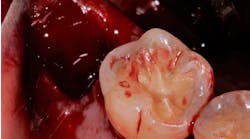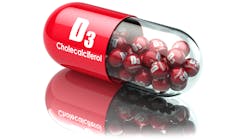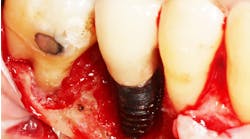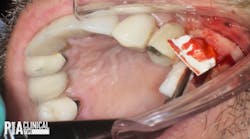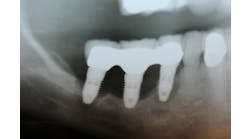Guided tissue regeneration: background to current indications and applications
Guided tissue regeneration (GTR) is a topic that has a long history. Before we get into the history of its development, we should probably understand what GTR is and, of course, define and review the tissues that we are attempting to regenerate.
Definitions
Guided tissue regeneration, as defined in the Glossary of Periodontal Terms 4th Edition, also has guided bone regeneration included in its definition as follows: “Procedures attempting to regenerate lost periodontal structures through differential tissue responses. Guided bone regeneration typically refers to ridge augmentation or bone regenerative procedures; guided tissue regeneration typically refers to regeneration of periodontal attachment. Barrier techniques, using materials such as expanded polytetrafluoroethylene, polyglactin, polylactic acid, calcium sulfate, and collagen, are employed in the hope of excluding epithelium and the gingival corium from the root or existing bone surface in the belief that they interfere with regeneration.” Both of these concepts are under the umbrella term of regeneration, which in itself is defined as, “reproduction or reconstruction of a lost or injured part.”
RELATED | The use of stem cells in dental implant site development
Although we aim for regeneration as an ultimate result, this is very hard to accomplish. In order to state that regeneration has occurred, histology is needed to determine if all lost tissues have been formed. These tissues include cementum, periodontal ligament, and bone. Usually regeneration only occurs as a partial phenomenon, leaving more of the completed healing in a repaired state. What is more commonly found in our studies is what is termed “repair.” This term is defined in the Glossary of Periodontal Terms as “The healing of a wound by tissue that does not fully restore the architecture or the function of the part.” Two forms of repair are reattachment and new attachment. If a tissue has received a clean incision or trauma, healing by reattachment occurs and this is defined as, “tissues being attached again with the reunion of epithelial and connective tissue with a root surface.” Like in many surgical periodontal procedures, the tissues are elevated for access and then replaced and closed. Healing after an event like this is a prime example of reattachment.
ADDITIONAL READING |Review of the treatment protocols for peri-implantitis
When we utilize the technique of guided tissue regeneration, we usually get the form of repair that we refer to as new attachment. The definition, according to the Glossary of Periodontal Terms, is quite broad when evaluated from a histological perspective: “the union of epithelium or connective tissue with a root surface that has been deprived of its original attachment apparatus. This new attachment may be epithelial adhesion and/or connective tissue adaptation or attachment and may include new cementum.” Where the definition becomes broadened, in this author’s opinion, is the mention of “may include new cementum.” Either way, if new cementum is regenerated or not, we are still left with a new attachment to a root that has suffered bone loss consequences of periodontal disease.
After any study, animal or human, results have to be obtained and analyzed. The assessment of guided tissue regeneration is usually done by one of a few methods. According to Lindhe’s text, periodontal probing, radiographic analysis, re-entry, and histological evaluation are all techniques employed to assess the results of guided tissue regeneration. Histological evaluation is the gold standard and it requires block specimens, which are hard to obtain from human study subjects for ethical reasons. Many early studies using nonresorbable barrier membranes were able to visualize the grafting results on re-entry to the site during removal of the membrane. Most current studies rely on probing depths and radiographic evaluation for assessment of their guided tissue regeneration procedures.
Membranes
Once the concept of guided tissue regeneration was conceived and proven in animal and human studies, the next concerns needed to be placed on membranes. The purpose of barrier membranes are:
- Exclusion of cells
- Space maintenance
- Clot stabilization
The design criteria for the membrane are explained in Lindhe’s text as follows:
- Biocompatable
- Exclude undesirable cell types
- Allows tissue integration
- Creates and maintains space
- Provided in configurations easy to trim and place
Membranes come in two types based on the characteristic of resorbability: nonresorbable and resorbable membranes, with the former needing an additional surgery for retrieval. The original nonresorbable membranes were made from either expanded polytetrafluoroethylene (ePTFE) produced by GoreTex in Flagstaff, Ariz., or cellulose acetate such as the Millipore filter used by Nyman in 1982. A study done in 1984 by Gottlow showed that there was a considerable increase in attachment when a membrane was used, and there was no significant difference between types of resorbable membranes. As stated previously, with nonresorbable membranes, they need to be retrieved after time has been allowed for tissue maturation. Murphy in 1995 completed a study that dealt with the question of when the membrane should be removed. They concluded that early removal was before six weeks and delayed removal was after six weeks. They experienced less matured bone and more recession with early retrieval and had more purulence and difficulty with removal with longer treatments. It was concluded that removal of membrane should occur around six weeks.
The other category of membranes includes the resorbable type. There are many different brands but two of the main sources are synthetic polymers and natural biomaterials such as cotton. Synthetic polymers, such as a product called Guidor by Sunstar, is a polylactic acid bilayer with function for six or more weeks. More popularly used membranes at this time are the collagen-derived membranes. The sources for these membranes include bovine or porcine tendon or dermis. Common brand names include Bio-Gide by Geistlich and BioMend (Extend) by Zimmer. They have different chemical structures and so different resorption rates ranging from six to 24 weeks.
Aspects of the osseous bone grafts and biologics are of importance, but the topics should be reviewed in a future dissertation in a more thorough manner than this paper was intended for.
Summary/conclusion
It is imperative that one should know that guided tissue regeneration is not a procedure for the treatment of periodontitis. Rather, it is rather an approach for regenerating defects that have been developed as a result of periodontitis. Therefore, appropriate periodontal treatment should always be completed before GTR is initiated.
This author believes that the topic of guided tissue regeneration is best summarized in Carranza’s text, “The future of periodontal reconstruction techniques will depend on the emergence of new products, which will lead to a predictable positive outcome when used in proper combination in select defects.” The clinician should attempt to differentiate between techniques that have been studied in depth and with acceptable results and those that are still experimental, although promising. Research papers must be critically evaluated for adequacy of controls, selection of cases, methods of evaluation, and long-term postoperative results. In addition, the clinician should remember that he or she is seeking “clinical” success, which is not always similar to “statistical” success. A gain in clinical attachment of half a millimeter may be statistically significant but not clinically significant.”
Once again, to summarize, GTR is a surgical technique employed by many clinicians. Although the term contains the word “regeneration,” our histological results are usually that of a form of repair termed “new attachment.” With the continuation of periodontal research and corporate alliance, one day we as a profession hope to have the ability to actually “regenerate” the periodontal apparatus including a functional periodontal ligament.
ALSO BY BRANDON G. KATZ, DDS |Ferrule: Why is it important, and how much do we need?
References
• Glossary of Periodontal Terms. 4th Edition. American Academy of Periodontology, 2001.
• Carranza's Clinical Periodontology, 10th Edition. Saunders Book Company, 2006.
• Clinical Periodontology and Implant Dentistry, 5th Edition. Blackwell Publishing, 2008.
• Atlas of Cosmetic and Reconstructive Periodontal Surgery. 3rd Edition. BC Decker Inc. 2006.
• Gargiulo, A. Dimensions and Relations of the Dentogingival Junction in Humans. J Perio 1961.
• Melcher A. On the Repair of Periodontal Tissues. J Perio 1976.
• Karring T, Nyman S, Lindhe J. Healing following implantation of periodontitis-affected roots into bone tissue. J Clin Perio 1980.
• Nyman S, Karring T, Lindhe J, Planten S. Healing following implantation of periodontitis-affected roots into gingival connective tissue. J Clin Perio 1980.
• Nyman S, et al. New attachment following surgical treatment of human periodontal disease. J Clin Perio 1982.
• Gottlow J, et al. New attachment formation as the result of controlled tissue regeneration. J Clin Perio 1984.
• Gottlow, et al. New attachment formation in the human periodontium by Guided Tissue Regeneration. J Clin Perio 1986.
• Murphy K. Postoperative healing complications associated with Gore-Tex periodontal material. Part II. Effect of complications on regeneration. IJPRD 1995.
• Mariotti A. Efficacy of chemical root surface modifiers in the treatment of periodontal disease. A systematic review. Ann Perio 2003.
• Cortellini P, et al. The modified papilla preservation technique. A new surgical approach for interproximal regenerative procedures. J Perio 1995.
• Cortellini P, et al. The simplified papilla preservation flap. A novel surgical approach for the management of soft tissues in regenerative procedures. IJPRD 1999.


